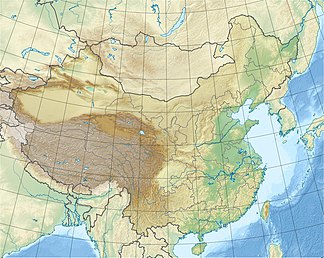Tianmu Shan
| Tianmu Shan | ||
|---|---|---|
| Highest peak | Xianren ( 1506 m ) | |
| location | Zhejiang ( PR China ) | |
|
|
||
| Coordinates | 30 ° 20 ′ N , 119 ° 25 ′ E | |
The Tianmu Mountains or Tianmu Shan ( 天目山 , Tiānmù shān - "Heavenly Eye Mountain") is a mountain range in the northwest of the Chinese province of Zhejiang , west of Hangzhou .
It runs from southwest to northeast and borders the Central Anhui Plain ( Wanzhong Pingyuan ). It consists of an eastern and a western part ( Dongtianmu Shan and Xitianmu Shan ).
According to a recent study, the increasingly growing ginkgos in the western Tianmu Mountains may have been introduced there by Buddhist monks. Tree species such as the Japanese cake tree (Katsura tree), Chinese tulip tree , Yulan magnolia and Japanese sago palm fern ( Cycas revoluta ) grow here . The golden larch can also be found there.
The Tianmu Shan was added to the list of biosphere reserves by UNESCO in 1996 . Since 2008, the "Museum of the Tianmushan National Nature Reserve" has been located here as an extension of the Zhejiang Natural History Museum . The Tianmushan site ( Tianmu Shan yizhi ) of the Shang and Zhou period in Jiangyan ( 姜堰 市 ) has been on the list of monuments of the People's Republic of China (6-77) since 2006 .
Its attractions include the Buddhist Chanyuan Temple ( 禅 源 寺 ) from the Ming Dynasty and the Chan (Japanese Zen) temple Shizikou ( 狮子 口 ), the origin of the Linji school ( Linji zong ) - one Forerunner of the Rinzai school of Buddhism - from the time of the Mongol dynasty .
A song-time tea cup type with the Japanese name Temmoku (the Japanese word for the mountains) was exported from there to Japan for ritual tea drinking .
See also
literature
- Muhammad Ishtiaq Chaudhary, Q. He, YY Cheng, PG Xiao: Ethnobotany of Medicinal Plants from Tian Mu Shan Biosphere Reserve, Zhejiang Province, China . In: Asian Journal of Plant Sciences . Volume 5, Number 4, 2006, pp. 646-653, PDF .
- L. Shen, X.-Y. Chen, X. Zhang, Y.-Y. Li, C.-X. Fu, Y.-X. Qiu: Genetic variation of Ginkgo biloba L. (Ginkgoaceae) based on cpDNA PCR-RFLPs: inference of glacial refugia . In: Heredity . Volume 94, 2005, pp. 396-401, doi: 10.1038 / sj.hdy.6800616
- Peter Del Tredici, Hsieh Ling and Guang Yang: The Ginkgos of Tian Mu Shan . In: Conservation Biology . Volume 6, Number 2, 1992, pp. 202-209, doi: 10.1046 / j.1523-1739.1992.620202.x .
Web links
- Tianmu Mountain
- Tianmu Mountain National Reserve
- Mountain Tianmu - The Base for Scientific Research and Education
- Ginkgo biloba trees in the Tianmu Shan Reserve (Xitianmu Shan)
- Tenmoku Teabowls (Kyoto National Museum)
Footnotes
- ↑ L. Shen, XY Chen, et al. a .: Genetic variation of Ginkgo biloba L. (Ginkgoaceae) based on cpDNA PCR-RFLPs: inference of glacial refugia. In: Heredity. Volume 94, Number 4, April 2005, pp. 396-401, ISSN 0018-067X . doi: 10.1038 / sj.hdy.6800616 . PMID 15536482 .
- ^ Tianmu Mountain National Reserve. (No longer available online.) In: chinaculture.org. Archived from the original on September 23, 2015 ; accessed on January 6, 2015 . Info: The archive link was inserted automatically and has not yet been checked. Please check the original and archive link according to the instructions and then remove this notice.
- ↑ Peter Haggett: Encyclopedia of World Geography. Marshall Cavendish, 2001, ISBN 978-0-7614-7289-6 , p. 2808. Limited preview in Google Book Search
- ^ Yunnan Tourism, Yunnan Tourist Information - ChinaDiscover. In: chinadiscover.net. Retrieved January 6, 2015 .
- ↑ Tea bowl by Jürgen Röthlingshöfer ( memento from September 30, 2004 in the Internet Archive ) In: bz.nuernberg.de
